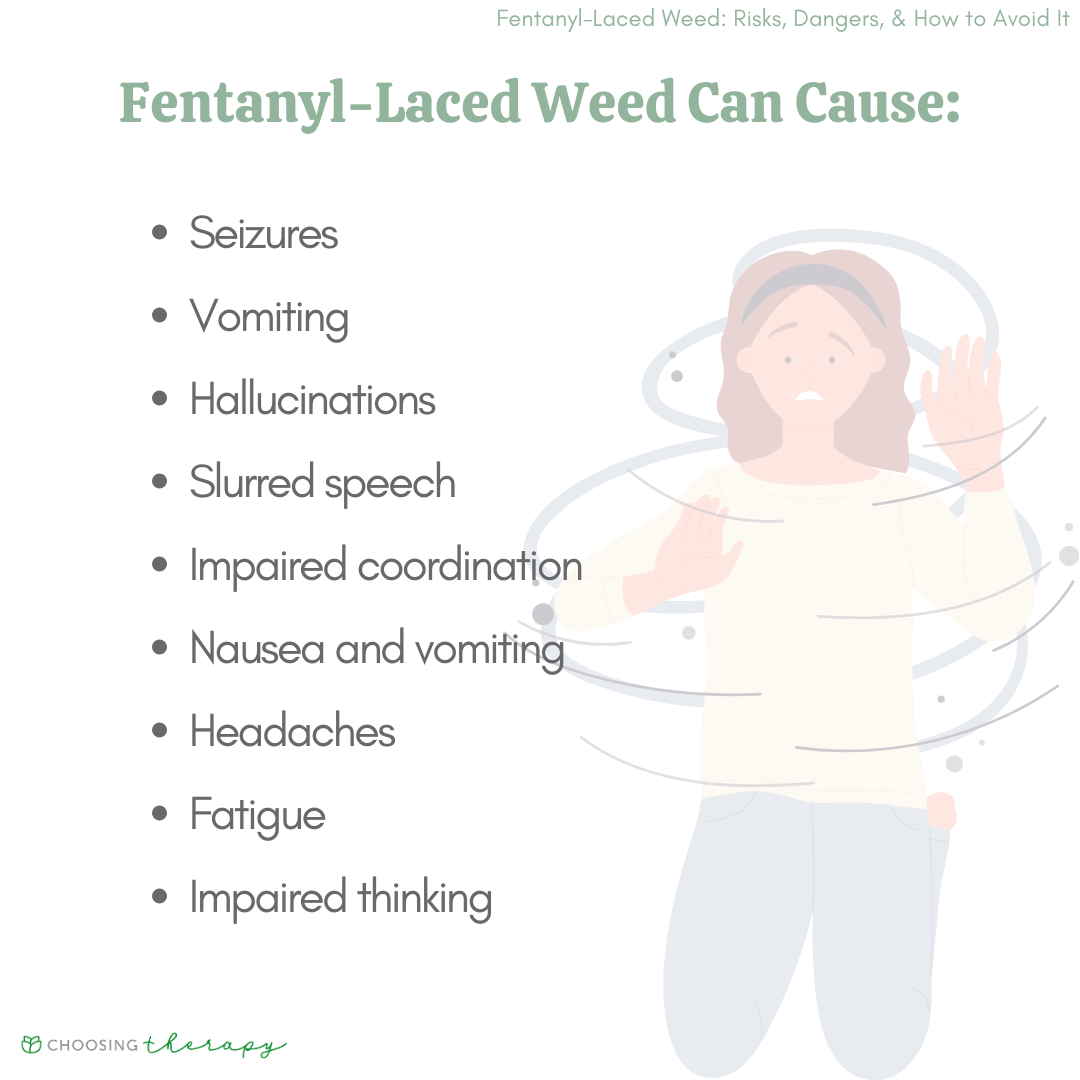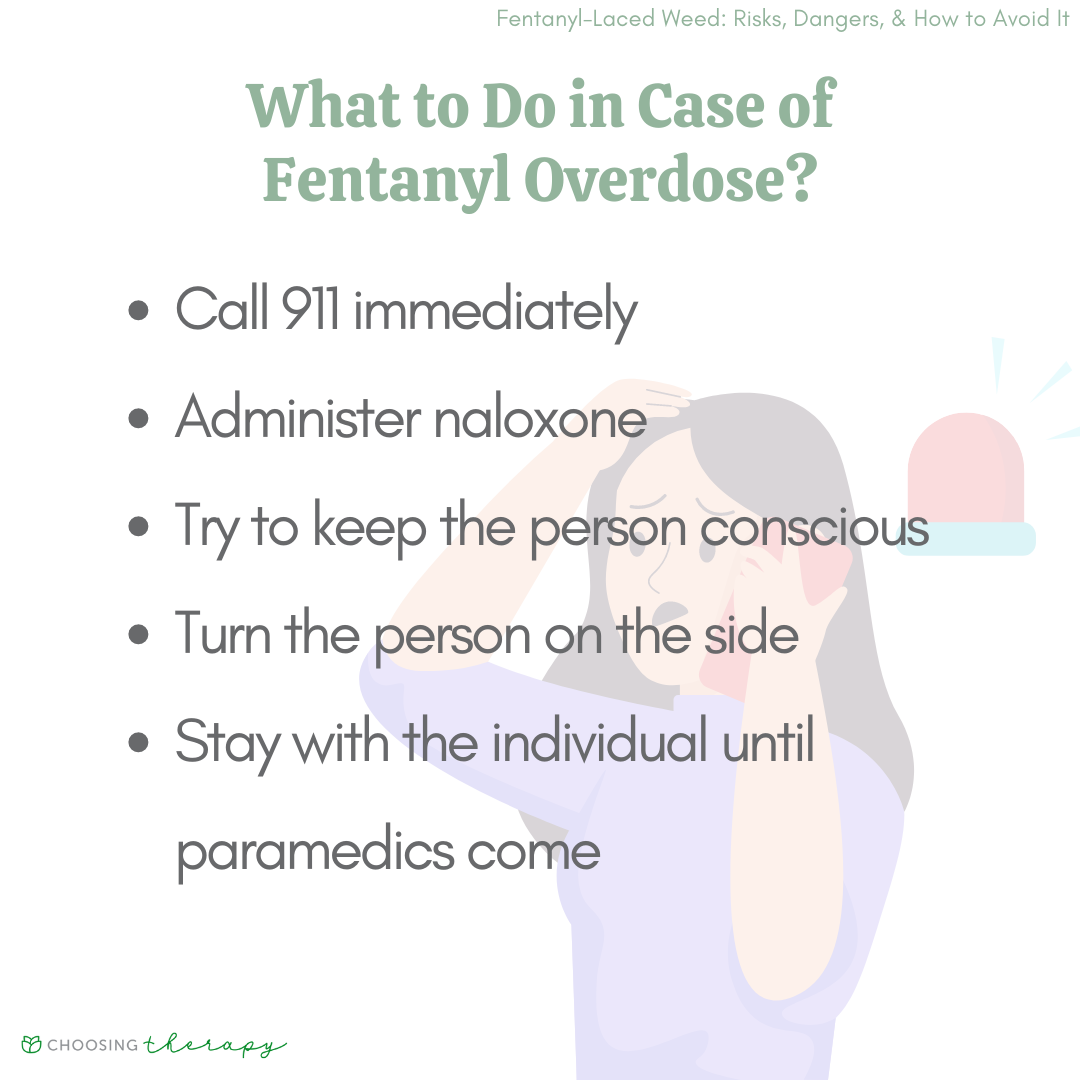Fentanyl-laced drugs represent an ongoing epidemic in America, and it’s one of the leading causes of overdoses. Fentanyl isn’t inherently visible to the naked eye, and it’s commonly mixed with substances like cocaine, methamphetamine, heroin, and other pills.1 While marijuana is generally considered safe, some dealers cut it with fentanyl. If fentanyl-laced weed is consumed, it can be fatal.
Workit Health - Online Treatment for Opioids or Alcohol, Including Medication. Modern, personalized recovery that combines medication, a supportive community, and helpful content. Covered by many insurance plans. Currently available in FL, TX, OH, MI, and NJ. Learn more
What Is Fentanyl-Laced Weed?
Fentanyl can be added to other illicit substances because it’s cheap, addictive, and can be easily smuggled (because small amounts are so extraordinarily powerful). Dealers generate a better profit margin by using this substance. It amplifies the effects of marijuana, and anything laced with fentanyl can make the substance far more addictive.
Fentanyl is a synthetic opioid intended for severe pain management or cancer treatment within clinical settings. But it’s also developed by individuals in non-pharmaceutical forms. Fentanyl is considered to be 50x more potent than heroin and 80-100x stronger than morphine. Research shows that nearly 7 out of 10 drug overdoses involve fentanyl.2
What Are the Effects of Fentanyl in Weed?
The impact of fentanyl on weed can range from mild to severe, and some effects may appear sooner than later. Both fentanyl and weed are depressants- marijuana impacts more of the central nervous system, and opioids affect the brain’s opioid receptors. Using both substances simultaneously tends to heighten the effects of each drug.
Marijuana’s side effects include:
- Relaxation
- Dry mouth
- Headaches
- Loss of coordination
- Increased appetite
- Increased heart rate
- Reduced alertness
- Fatigue
Effects of taking fentanyl include:3
- Pain relief
- Relaxation
- Confusion
- Drowsiness
- Nausea
- Pupillary constriction
Fentanyl-laced weed can cause:
- Seizures
- Vomiting
- Hallucinations
- Slurred speech
- Impaired coordination
- Nausea and vomiting
- Headaches
- Fatigue
- Impaired thinking
Fentanyl Weed Overdose Risks
While it’s unlikely someone can overdose on weed alone, the greatest risk of using weed laced with fentanyl is an overdose. Because fentanyl is so potent, there is always a risk of overdosing on it. Likewise, if someone has never used opioids, and they unknowingly take them when using weed, the chance of overdosing may be much greater (as the body has no tolerance for opioids).
Signs of a fentanyl overdose are:
- Cold, clammy skin
- Slowed or labored breathing
- Nausea and vomiting
- Chest pain
- Unconsciousness
- Seizures
- Unresponsive to hearing others
- Small pupils
- Blue or purplish skin
- Discolored lips or fingernails
- Snoring or gurgling sounds
Help For Addiction Ria Health: Effective, Evidence-Based Alcohol Treatment 100% Online Quickly change your relationship to alcohol with our at-home program. On average, Ria Health members reduce their BAC levels by 50% in 3 months in the program. Services are covered by many major health plans. Visit Ria Health Workit Health – Online Treatment for Opioids or Alcohol, Including Medication. Modern, personalized recovery that combines medication, a supportive community, and helpful content. Covered by many insurance plans. Currently available in FL, TX, OH, MI, and NJ. Visit Workit Health Best Drug Addiction Rehab Centers – Find the best local detox or drug rehab center covered by your health insurance. Search by location, condition, insurance, and more. Read reviews. Start Your Search
How to Tell If Fentanyl Is in Weed
It can be challenging to determine if fentanyl is in a substance based on looking at it alone. Likewise, it’s unknown how common fentanyl-laced marijuana is within the United States. First, it’s important to smell the marijuana. Fresh weed smells like plants or leaves. If anything smells harsh (like acetone or gasoline), it may have been laced. Any signs of crystals (blue, white, or brown) may indicate other substances, including fentanyl.
People can also test for fentanyl by using a fentanyl drug-testing kit. These test trips use the same technology as at-home pregnancy tests and can detect fentanyl in drug samples diluted in water.4 In addition, when possible, purchase marijuana from a state-licensed dispensary. These places must adhere to testing to ensure customers receive high-quality products.
Myths About Fentanyl in Weed
The risk of laced marijuana is generally low. But anytime you buy drugs off the street, there’s a chance you won’t know what those drugs contain. Likewise, contamination is always possible, particularly if dealers also deal opioids or stimulants. You can overdose on fentanyl even if you smoke the drug (which discredits the idea that you can only overdose when using intravenously).
What to Do in Case of Fentanyl Overdose?
Trace amounts of fentanyl can still cause an overdose. The risk is highest when combining fentanyl with other drugs, and the risk may be even higher for people who don’t have a tolerance or history using opioids. Most states have Good Samaritan laws that protect you from criminal penalties if you call 911 to save someone from a drug overdose.5
If you believe someone is overdosing on fentanyl:
- Call 911 immediately
- Administer naloxone
- Try to keep the person conscious
- Turn the person on the side
- Stay with the individual until paramedics come
Workit Health - Online Treatment for Opioids or Alcohol, Including Medication. Modern, personalized recovery that combines medication, a supportive community, and helpful content. Covered by many insurance plans. Currently available in FL, TX, OH, MI, and NJ. Learn more
Treating Fentanyl Addiction
Fentanyl can be highly addictive, and people who develop an addiction to fentanyl may require professional intervention and support to recovery. Opioid treatment is often comprehensive, and it may include a combination of therapy, medication, and significant lifestyle changes. In addition, making a relapse prevention plan is important for anyone struggling with addiction.
Treating a fentanyl addiction often requires a multifaceted approach, including:
Therapy & Support Groups
All drug addictions are challenging, but overcoming opioid use disorder can be particularly difficult. The cravings tend to be extremely high, and the withdrawal symptoms are often incredibly uncomfortable. Support groups provide camaraderie and accountability for recovery. Therapy offers numerous benefits, including emotional support, coping skills, and treating co-occurring mental health issues. It’s important to find a therapist who specializes in addiction.
Therapy is an effective treatment for managing addictive tendencies, including options like:
- Cognitive behavioral therapy (CBT): CBT is a well-known, evidence-based model that focuses on the connection between thoughts, feelings, and behaviors. It can help with addictions and many other mental health issues.
- Dialectical behavior therapy (DBT): DBT can treat addictive tendencies by strengthening skills in mindfulness, interpersonal skills, emotional regulation, and distress tolerance.
- Motivational interviewing: Motivational interviewing helps people experiencing ambivalence over recovering from addiction.
- Schema therapy: Schema therapy has been shown to be effective for changing longstanding, negative behavioral patterns.
- EMDR: In later stages of recovery, EMDR may be helpful for addressing traumas underlying addictive patterns.
- Interpersonal therapy: IPT resolves interpersonal conflict, and it may be beneficial for treating underlying symptoms of anxiety and depression.
Intensive Outpatient Treatment
Intensive outpatient treatment (IOP) offers supportive clinical programming for people recovering from substance use disorders. This type of treatment typically includes 12-25 clinical hours per week, and treatment may consist of a combination of group therapy, individual therapy, and case management. Treatment lengths vary, but IOP can last between 1-12 months. Clients can use their health insurance or pay privately for this treatment.
Rehab & Detox Centers
There are also numerous rehab (inpatient) options for fentanyl addiction. Costs vary, but most people use their health insurance to subsidize the majority of treatment fees. When examining inpatient versus outpatient rehab, it’s important to consider the extent and frequency of drug use. People with more severe addictions tend to benefit from a period of inpatient treatment.
In My Experience
Buying drugs is always risky, and it’s especially important for parents to know the risks when it comes to their children. Because marijuana is legal in many states, it’s best to purchase it from a trusted dispensary. That said, if drugs are impacting your well-being, relationships, or overall health, it may be time to reevaluate using them. Drug addiction can be a slippery slope, and symptoms often worsen progressively over time.
To help our readers take the next step in their mental health journey, Choosing Therapy has partnered with leaders in mental health and wellness. Choosing Therapy is compensated for marketing by the companies included below. Online Treatment for Opioids or Alcohol, Including Medication. Workit Health – Modern, personalized recovery that combines medication, a supportive community, and helpful content. Covered by many insurance plans. Currently available in FL, TX, OH, MI, and NJ. Visit Workit Health Alcohol Treatment – Cut Back or Quit Entirely Ria Health – Quickly change your relationship to alcohol with our at-home program. On average, members reduce their BAC levels by 50% in 3 months in the program. Services are covered by many major health plans. Visit Ria Health Drug Addiction Rehab Centers Recovery.com – Find the best local detox or drug rehab center covered by your health insurance. Search by location, condition, insurance, and more. Read reviews. Start Your Search Telehealth Treatment For Opioid Use Disorder Bicycle Health – offers therapy, support, and medication for addiction treatment (MAT). MAT offers the lowest relapse rates for opioid use disorder, helping people to stop using opioids with minimal physical discomfort. Covered by most major insurance. Visit Bicycle Health Drinking Moderation Sunnyside – Want to drink less? Sunnyside helps you ease into mindful drinking at your own pace. Think lifestyle change, not a fad diet. Develop new daily routines, so you maintain your new habits for life. Take a 3 Minute QuizAdditional Resources
Best Online Medication-Assisted Treatment Programs Online medication-assisted treatment programs are fairly new to the telehealth industry, but existing companies are expanding quickly with new programs emerging every day. It’s important to explore your options and understand the level of virtual care available so you can choose the best addiction treatment program for you.
Best Mindful Drinking Apps If you’re thinking about joining the sober curious movement and you’d like to cut back on drinking, mindful drinking apps are a great place to start. Practicing mindful drinking can take some time, attention, and patience, but with the help of the right app, you can completely transform your relationship with alcohol.









